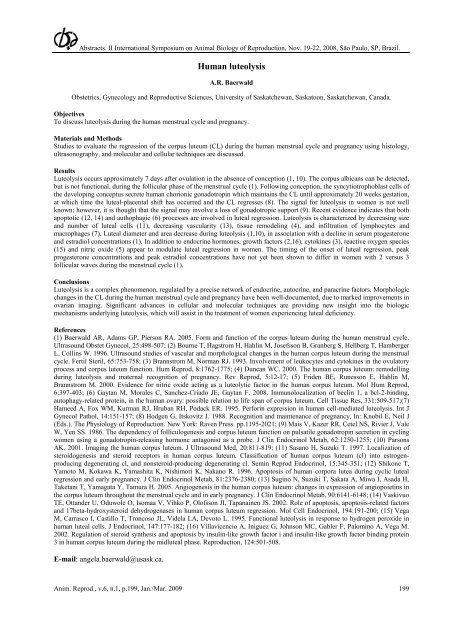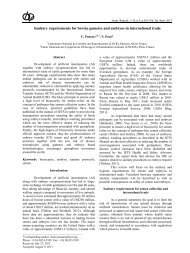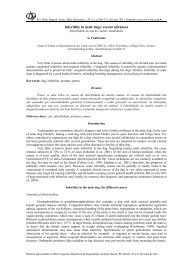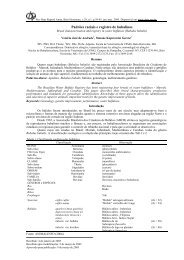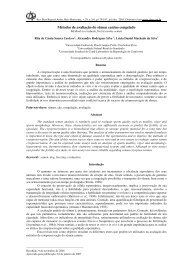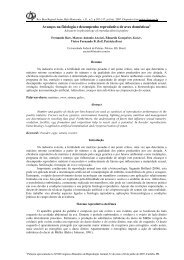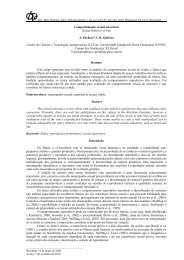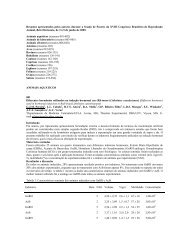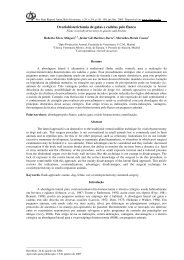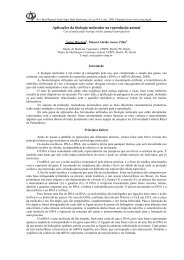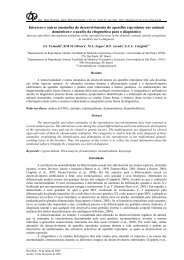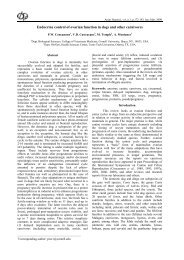Recent advances in ovulation synchronization and superovulation in ...
Recent advances in ovulation synchronization and superovulation in ...
Recent advances in ovulation synchronization and superovulation in ...
Create successful ePaper yourself
Turn your PDF publications into a flip-book with our unique Google optimized e-Paper software.
Abstracts. II International Symposium on Animal Biology of Reproduction, Nov. 19-22, 2008, São Paulo, SP, Brazil.<br />
Human luteolysis<br />
A.R. Baerwald<br />
Obstetrics, Gynecology <strong>and</strong> Reproductive Sciences, University of Saskatchewan, Saskatoon, Saskatchewan, Canada.<br />
Objectives<br />
To discuss luteolysis dur<strong>in</strong>g the human menstrual cycle <strong>and</strong> pregnancy.<br />
Materials <strong>and</strong> Methods<br />
Studies to evaluate the regression of the corpus luteum (CL) dur<strong>in</strong>g the human menstrual cycle <strong>and</strong> pregnancy us<strong>in</strong>g histology,<br />
ultrasonography, <strong>and</strong> molecular <strong>and</strong> cellular techniques are discussed.<br />
Results<br />
Luteolysis occurs approximately 7 days after <strong>ovulation</strong> <strong>in</strong> the absence of conception (1, 10). The corpus albicans can be detected,<br />
but is not functional, dur<strong>in</strong>g the follicular phase of the menstrual cycle (1). Follow<strong>in</strong>g conception, the syncytiotrophoblast cells of<br />
the develop<strong>in</strong>g conceptus secrete human chorionic gonadotrop<strong>in</strong> which ma<strong>in</strong>ta<strong>in</strong>s the CL until approximately 20 weeks gestation,<br />
at which time the luteal-placental shift has occurred <strong>and</strong> the CL regresses (8). The signal for luteolysis <strong>in</strong> women is not well<br />
known; however, it is thought that the signal may <strong>in</strong>volve a loss of gonadotropic support (9). <strong>Recent</strong> evidence <strong>in</strong>dicates that both<br />
apoptotic (12, 14) <strong>and</strong> authophagic (6) processes are <strong>in</strong>volved <strong>in</strong> luteal regression. Luteolysis is characterized by decreas<strong>in</strong>g size<br />
<strong>and</strong> number of luteal cells (11), decreas<strong>in</strong>g vascularity (13), tissue remodel<strong>in</strong>g (4), <strong>and</strong> <strong>in</strong>filtration of lymphocytes <strong>and</strong><br />
macrophages (7). Luteal diameter <strong>and</strong> area decrease dur<strong>in</strong>g luteolysis (1,10), <strong>in</strong> association with a decl<strong>in</strong>e <strong>in</strong> serum progesterone<br />
<strong>and</strong> estradiol concentrations (1). In addition to endocr<strong>in</strong>e hormones, growth factors (2,16), cytok<strong>in</strong>es (3), reactive oxygen species<br />
(15) <strong>and</strong> nitric oxide (5) appear to modulate luteal regression <strong>in</strong> women. The tim<strong>in</strong>g of the onset of luteal regression, peak<br />
progesterone concentrations <strong>and</strong> peak estradiol concentrations have not yet been shown to differ <strong>in</strong> women with 2 versus 3<br />
follicular waves dur<strong>in</strong>g the menstrual cycle (1).<br />
Conclusions<br />
Luteolysis is a complex phenomenon, regulated by a precise network of endocr<strong>in</strong>e, autocr<strong>in</strong>e, <strong>and</strong> paracr<strong>in</strong>e factors. Morphologic<br />
changes <strong>in</strong> the CL dur<strong>in</strong>g the human menstrual cycle <strong>and</strong> pregnancy have been well-documented, due to marked improvements <strong>in</strong><br />
ovarian imag<strong>in</strong>g. Significant <strong>advances</strong> <strong>in</strong> cellular <strong>and</strong> molecular techniques are provid<strong>in</strong>g new <strong>in</strong>sight <strong>in</strong>to the biologic<br />
mechanisms underly<strong>in</strong>g luteolysis, which will assist <strong>in</strong> the treatment of women experienc<strong>in</strong>g luteal deficiency.<br />
References<br />
(1) Baerwald AR, Adams GP, Pierson RA. 2005. Form <strong>and</strong> function of the corpus luteum dur<strong>in</strong>g the human menstrual cycle.<br />
Ultrasound Obstet Gynecol, 25:498-507; (2) Bourne T, Hagstrom H, Hahl<strong>in</strong> M, Josefsson B, Granberg S, Hellberg T, Hamberger<br />
L, Coll<strong>in</strong>s W. 1996. Ultrasound studies of vascular <strong>and</strong> morphological changes <strong>in</strong> the human corpus luteum dur<strong>in</strong>g the menstrual<br />
cycle. Fertil Steril, 65:753-758; (3) Brannstrom M, Norman RJ. 1993. Involvement of leukocytes <strong>and</strong> cytok<strong>in</strong>es <strong>in</strong> the ovulatory<br />
process <strong>and</strong> corpus luteum function. Hum Reprod, 8:1762-1775; (4) Duncan WC. 2000. The human corpus luteum: remodell<strong>in</strong>g<br />
dur<strong>in</strong>g luteolysis <strong>and</strong> maternal recognition of pregnancy. Rev Reprod, 5:12-17; (5) Friden BE, Runesson E, Hahl<strong>in</strong> M,<br />
Brannstrom M. 2000. Evidence for nitric oxide act<strong>in</strong>g as a luteolytic factor <strong>in</strong> the human corpus luteum. Mol Hum Reprod,<br />
6:397-403; (6) Gaytan M, Morales C, Sanchez-Criado JE, Gaytan F. 2008. Immunolocalization of becl<strong>in</strong> 1, a bcl-2-b<strong>in</strong>d<strong>in</strong>g,<br />
autophagy-related prote<strong>in</strong>, <strong>in</strong> the human ovary: possible relation to life span of corpus luteum. Cell Tissue Res, 331:509-517;(7)<br />
Hameed A, Fox WM, Kurman RJ, Hruban RH, Podack ER. 1995. Perfor<strong>in</strong> expression <strong>in</strong> human cell-mediated luteolysis. Int J<br />
Gynecol Pathol, 14:151-157; (8) Hodgen G, Itskovitz J. 1988. Recognition <strong>and</strong> ma<strong>in</strong>tenance of pregnancy, In: Knobil E, Neil J<br />
(Eds.). The Physiology of Reproduction. New York: Raven Press. pp.1195-2021; (9) Mais V, Kazer RR, Cetel NS, Rivier J, Vale<br />
W, Yen SS. 1986. The dependency of folliculogenesis <strong>and</strong> corpus luteum function on pulsatile gonadotrop<strong>in</strong> secretion <strong>in</strong> cycl<strong>in</strong>g<br />
women us<strong>in</strong>g a gonadotrop<strong>in</strong>-releas<strong>in</strong>g hormone antagonist as a probe. J Cl<strong>in</strong> Endocr<strong>in</strong>ol Metab, 62:1250-1255; (10) Parsons<br />
AK. 2001. Imag<strong>in</strong>g the human corpus luteum. J Ultrasound Med, 20:811-819; (11) Sasano H, Suzuki T. 1997. Localization of<br />
steroidogenesis <strong>and</strong> steroid receptors <strong>in</strong> human corpus luteum. Classification of human corpus luteum (cl) <strong>in</strong>to estrogenproduc<strong>in</strong>g<br />
degenerat<strong>in</strong>g cl, <strong>and</strong> nonsteroid-produc<strong>in</strong>g degenerat<strong>in</strong>g cl. Sem<strong>in</strong> Reprod Endocr<strong>in</strong>ol, 15:345-351; (12) Shikone T,<br />
Yamoto M, Kokawa K, Yamashita K, Nishimori K, Nakano R. 1996. Apoptosis of human corpora lutea dur<strong>in</strong>g cyclic luteal<br />
regression <strong>and</strong> early pregnancy. J Cl<strong>in</strong> Endocr<strong>in</strong>ol Metab, 81:2376-2380; (13) Sug<strong>in</strong>o N, Suzuki T, Sakata A, Miwa I, Asada H,<br />
Taketani T, Yamagata Y, Tamura H. 2005. Angiogenesis <strong>in</strong> the human corpus luteum: changes <strong>in</strong> expression of angiopoiet<strong>in</strong>s <strong>in</strong><br />
the corpus luteum throughout the menstrual cycle <strong>and</strong> <strong>in</strong> early pregnancy. J Cl<strong>in</strong> Endocr<strong>in</strong>ol Metab, 90:6141-6148; (14) Vaskivuo<br />
TE, Ott<strong>and</strong>er U, Oduwole O, Isomaa V, Vihko P, Olofsson JI, Tapana<strong>in</strong>en JS. 2002. Role of apoptosis, apoptosis-related factors<br />
<strong>and</strong> 17beta-hydroxysteroid dehydrogenases <strong>in</strong> human corpus luteum regression. Mol Cell Endocr<strong>in</strong>ol, 194:191-200; (15) Vega<br />
M, Carrasco I, Castillo T, Troncoso JL, Videla LA, Devoto L. 1995. Functional luteolysis <strong>in</strong> response to hydrogen peroxide <strong>in</strong><br />
human luteal cells. J Endocr<strong>in</strong>ol, 147:177-182; (16) Villavicencio A, Iniguez G, Johnson MC, Gabler F, Palom<strong>in</strong>o A, Vega M.<br />
2002. Regulation of steroid synthesis <strong>and</strong> apoptosis by <strong>in</strong>sul<strong>in</strong>-like growth factor i <strong>and</strong> <strong>in</strong>sul<strong>in</strong>-like growth factor b<strong>in</strong>d<strong>in</strong>g prote<strong>in</strong><br />
3 <strong>in</strong> human corpus luteum dur<strong>in</strong>g the midluteal phase. Reproduction, 124:501-508.<br />
E-mail: angela.baerwald@usask.ca.<br />
Anim. Reprod., v.6, n.1, p.199, Jan./Mar. 2009 199


